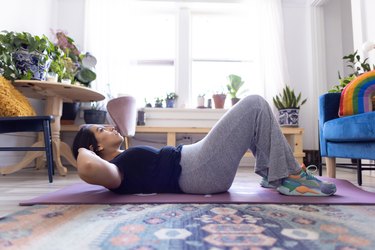
No matter your body size or shape, belly creases are natural and simply part of having a body. These creases can happen normally when you sit or move, even if you don't have overweight.
And don't worry: There's no medical need to get rid of stomach creases.
Video of the Day
Video of the Day
That said, if you're already on a weight-loss journey and looking for healthy ways to reduce excess belly fat, there is a sustainable way to do so — through a nutritious diet, exercise and positive lifestyle changes.
1. Stop Stressing About It
Before you turn to a fad diet or invest in "fat-burning" supplements, consider dedicating time to working on a more positive body image. The idea that "thinner is better" is deeply rooted in our society, but challenging this belief — in other words, unlearning our obsession with being thin — can have both mental and physical benefits.
In fact, stressing about your middle could actually backfire: Stress spikes your cortisol levels, which, over time, can trigger your body to store more belly fat, according to an April 2018 paper in Current Obesity Reports.
So instead of engaging in negative self-talk or looking to the scale for validation, take time to thank your body for what it does, reflect on what you like about yourself and choose clothes, foods and exercise that make you feel good.
Tip
If you struggle with improving your body image, consider finding a therapist who can help.
2. Burn More Calories
One of the first ways people try to lose belly fat is by burning more calories than they eat.
The Mayo Clinic used to suggest reducing your caloric intake by 500 calories to lose about 1 to 2 pounds per week. But now, it's recognized that the amount of weight loss can vary greatly from person to person, depending on factors like your overall health, age, genetics, metabolism, body composition and level of physical activity.
If you're unsure about how many calories you should get per day, talk to your doctor or a registered dietitian for guidance. According to Harvard Health Publishing, you shouldn't eat less than 1,200 to 1,500 calories per day, as this can cause malnutrition and other unwanted health effects.
And remember, eating too few calories is not the goal. Rapid weight loss is unhealthy and may cause you to gain more weight back in the long term, per a September 2020 report in Cureus.
It's also important to remember that you can't target fat loss. That means, you can't choose to lose fat specifically from your stomach; your fat loss will likely be widespread, per Johns Hopkins Medicine.
3. Incorporate More Nutritious Foods
Instead of focusing solely on cutting calories to reduce belly creases, try turning your attention to adding more nutritious foods to your meals. Not only will this aid weight-loss efforts, but it will help you get all the essential vitamins and minerals your body needs, per the Cleveland Clinic.
Aim to include:
- Complex carbohydrates in the form of whole grains like quinoa, brown rice or 100 percent whole-wheat bread.
- Lean sources of protein including fish like salmon, skinless chicken breast or turkey, eggs, nuts, beans and nonfat dairy.
- Fresh or frozen fruits and vegetables with each meal, like leafy greens, broccoli, berries, etc.
- Healthy fats from foods like fish, avocado and olive oil
Try to avoid:
- Foods high in sodium
- Ultra-processed foods like candy, sweets, chips, etc.
- Processed meats like deli meat or sausage
- Trans fats
A sample menu for the day could include:
- Breakfast: A piece of whole-grain toast topped with steamed spinach and a poached egg; or a bowl of oatmeal with fresh blueberries and chopped almonds
- Snack: A green smoothie, a handful of nuts, a cup of berries or a hard-boiled egg
- Lunch: A kale salad topped with red kidney beans or chopped chicken breast and an olive oil vinaigrette for healthy protein and fat
- Dinner: A delicious chicken, ginger and broccoli stir-fry over brown rice, or a hearty vegetarian bean and quinoa chili with a side of greens
4. Consider High-Fiber Foods or a Fiber Supplement
There is some research to suggest that increasing your fiber intake can help you lose weight, per a February 2015 study in the Annals of Internal Medicine.
This is likely because fiber can help you feel fuller for longer, helping you stick with your nutrition plan. On top of that, fiber firms up your stool and helps you poop (which may also relieve bloating), per the Mayo Clinic.
While there's no guarantee that eating fiber will reduce fat and fat lines on your stomach, in particular, it may help your overall fat-loss efforts.
5. Add Cardio to Your Workout Routine
Cardio (or aerobic) exercise is a great way to help you burn fat, per Houston Methodist. Try to get about 30 minutes of aerobic exercise at least five days a week, which can include swimming, running or cycling, per the Mayo Clinic.
Over time, you can try bumping it up to 60 minutes per day, if you have time in your schedule. You can try going for a long run, walking around the neighborhood or playing a game of tennis or pickleball.
To add intensity, you can try increasing the incline on your treadmill at the gym, or adding intervals of jogging during a walk.
Tip
Find aerobic exercise that you enjoy so you'll stay motivated. Staying consistent will help you achieve long-term fat-loss results.
6. Choose Exercises That Target Your Abdomen
While it's not possible to target fat loss to one particular part of your body, it's possible to exercise specific muscle groups to help them get stronger and appear firmer.
Abdominal exercises, in particular, aren't necessarily going to reduce belly creases, but they can make your abdomen look and feel more toned.
Some bodyweight exercises that target your abs include:
- Crunches
- Planks
- Plank variations (like side planks)
- Leg lifts
- Wood chops
If you think you'll get tired of doing these exercises, try taking a group fitness class that incorporates abdominal work, like Pilates or yoga. Not only will this strengthen your core, but it can also improve your posture (more on this below).
7. Work on Improving Your Posture
Poor posture can not only hurt your back, but it can also deepen the appearance of belly creases and lines, especially if you slouch when you sit.
When you improve your posture and sit up straight, you may avoid some stomach rolling and creasing, while also improving the health of your spine, per the Mayo Clinic.
To help you sit up straighter, try setting a reminder on your phone that will notify you every so often to sit up straight (like if you work at a desk for hours at a time).
You can also try incorporating the abdominal exercises listed in the previous step, or other back and posterior exercises, including:
- Reverse flys
- Inverted rows
- Standing cable rows: which also help pull your shoulders back and shoulder blades together, to stop slumping
Tip
Follow-up these exercises with some stretching that focuses on your hamstrings, hip flexors and pectoral muscles, all of which can tighten as you sit during the day, contributing to poor posture.
8. Drink Plenty of Water
Staying hydrated is not only important for your overall health, but it could help your fat-loss efforts, too.
Drinking enough water can help you feel fuller longer, which may help curb food cravings so you can stick with your diet plan. It can also help remove waste and reduce bloating, per Johns Hopkins University.
Aim to get anywhere between 11.5 and 15.5 cups of water per day through drinking or water-rich foods, per the National Academies of Sciences, Engineering and Medicine.
The Bottom Line
Belly creases and lines are completely normal, no matter what body size or shape you have. When you sit or slouch, your stomach may crunch and cause these creases, which may also stick around after you stand up.
There's isn't a guaranteed way to "get rid" of belly creases, but if they are something you're concerned about, you can work to reduce belly fat to tone your midsection and possibly reduce their appearance.
But above all, remember to be kind to yourself and your body. Here are 10 tips to help you nurture a better relationship with your body, no matter where you are on your journey.
- Mayo Clinic: "Counting Calories: Get Back to Weight-Loss Basics
- Harvard Health Publishing: "Calorie Counting Made Easy"
- Cureus: "Have Our Attempts to Curb Obesity Done More Harm Than Good?"
- Johns Hopkins Medicine: "8 Ways to Lose Belly Fat and Live a Healthier Life"
- Cleveland Clinic: "9 Foods to Help You Lose Weight"
- Annals of Internal Medicine: "Single-component versus multicomponent dietary goals for the metabolic syndrome: a randomized trial"
- Mayo Clinic: "Dietary Fiber: Essential for a Healthy Diet"
- Houston Methodist: "3 Ways to Improve Your Fat-Burning Workout Plan"
- Mayo Clinic: "How Much Should the Average Adult Exercise Every Day?"
- Mayo Clinic: "Good Posture Tips"
- Johns Hopkins University: "Yes, drinking more water may help you lose weight"
- National Academies of Sciences, Engineering and Medicine: "Report Sets Dietary Intake Levels for Water, Salt, and Potassium To Maintain Health and Reduce Chronic Disease Risk"
- Current Obesity Reports: "Stress and Obesity: Are There More Susceptible Individuals?"


